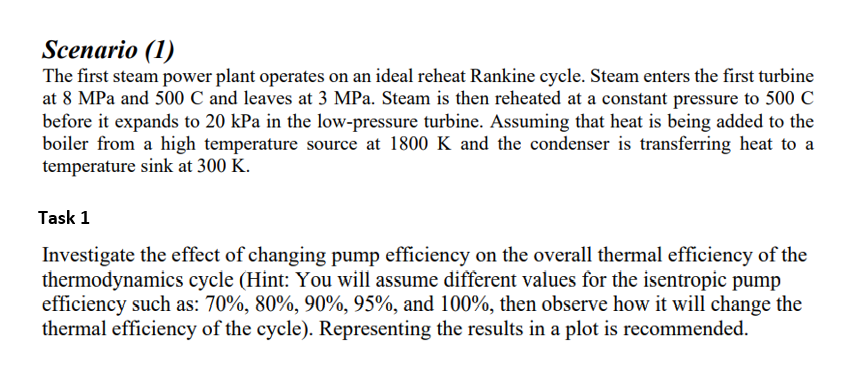Scenario (1) The first steam power plant operates on an ideal reheat Rankine cycle. Steam enters the first turbine at 8 MPa and 500 C and leaves at 3 MPa. Steam is then reheated at a constant pressure to 500 C before it expands to 20 kPa in the low-pressure turbine. Assuming that heat is being added to the boiler from a high temperature source at 1800 K and the condenser is transferring heat to a temperature sink at 300 K. Task 1 Investigate the effect of changing pump efficiency on the overall thermal efficiency of the thermodynamics cycle (Hint: You will assume different values for the isentropic pump efficiency such as: 70%, 80%, 90%, 95%, and 100%, then observe how it will change the
Scenario (1) The first steam power plant operates on an ideal reheat Rankine cycle. Steam enters the first turbine at 8 MPa and 500 C and leaves at 3 MPa. Steam is then reheated at a constant pressure to 500 C before it expands to 20 kPa in the low-pressure turbine. Assuming that heat is being added to the boiler from a high temperature source at 1800 K and the condenser is transferring heat to a temperature sink at 300 K. Task 1 Investigate the effect of changing pump efficiency on the overall thermal efficiency of the thermodynamics cycle (Hint: You will assume different values for the isentropic pump efficiency such as: 70%, 80%, 90%, 95%, and 100%, then observe how it will change the
Elements Of Electromagnetics
7th Edition
ISBN:9780190698614
Author:Sadiku, Matthew N. O.
Publisher:Sadiku, Matthew N. O.
ChapterMA: Math Assessment
Section: Chapter Questions
Problem 1.1MA
Related questions
Question

Transcribed Image Text:Scenario (1)
The first steam power plant operates on an ideal reheat Rankine cycle. Steam enters the first turbine
at 8 MPa and 500 C and leaves at 3 MPa. Steam is then reheated at a constant pressure to 500 C
before it expands to 20 kPa in the low-pressure turbine. Assuming that heat is being added to the
boiler from a high temperature source at 1800 K and the condenser is transferring heat to a
temperature sink at 300 K.
Task 1
Investigate the effect of changing pump efficiency on the overall thermal efficiency of the
thermodynamics cycle (Hint: You will assume different values for the isentropic pump
efficiency such as: 70%, 80%, 90%, 95%, and 100%, then observe how it will change the
thermal efficiency of the cycle). Representing the results in a plot is recommended.
Expert Solution
This question has been solved!
Explore an expertly crafted, step-by-step solution for a thorough understanding of key concepts.
Step by step
Solved in 2 steps with 3 images

Knowledge Booster
Learn more about
Need a deep-dive on the concept behind this application? Look no further. Learn more about this topic, mechanical-engineering and related others by exploring similar questions and additional content below.Recommended textbooks for you

Elements Of Electromagnetics
Mechanical Engineering
ISBN:
9780190698614
Author:
Sadiku, Matthew N. O.
Publisher:
Oxford University Press

Mechanics of Materials (10th Edition)
Mechanical Engineering
ISBN:
9780134319650
Author:
Russell C. Hibbeler
Publisher:
PEARSON

Thermodynamics: An Engineering Approach
Mechanical Engineering
ISBN:
9781259822674
Author:
Yunus A. Cengel Dr., Michael A. Boles
Publisher:
McGraw-Hill Education

Elements Of Electromagnetics
Mechanical Engineering
ISBN:
9780190698614
Author:
Sadiku, Matthew N. O.
Publisher:
Oxford University Press

Mechanics of Materials (10th Edition)
Mechanical Engineering
ISBN:
9780134319650
Author:
Russell C. Hibbeler
Publisher:
PEARSON

Thermodynamics: An Engineering Approach
Mechanical Engineering
ISBN:
9781259822674
Author:
Yunus A. Cengel Dr., Michael A. Boles
Publisher:
McGraw-Hill Education

Control Systems Engineering
Mechanical Engineering
ISBN:
9781118170519
Author:
Norman S. Nise
Publisher:
WILEY

Mechanics of Materials (MindTap Course List)
Mechanical Engineering
ISBN:
9781337093347
Author:
Barry J. Goodno, James M. Gere
Publisher:
Cengage Learning

Engineering Mechanics: Statics
Mechanical Engineering
ISBN:
9781118807330
Author:
James L. Meriam, L. G. Kraige, J. N. Bolton
Publisher:
WILEY